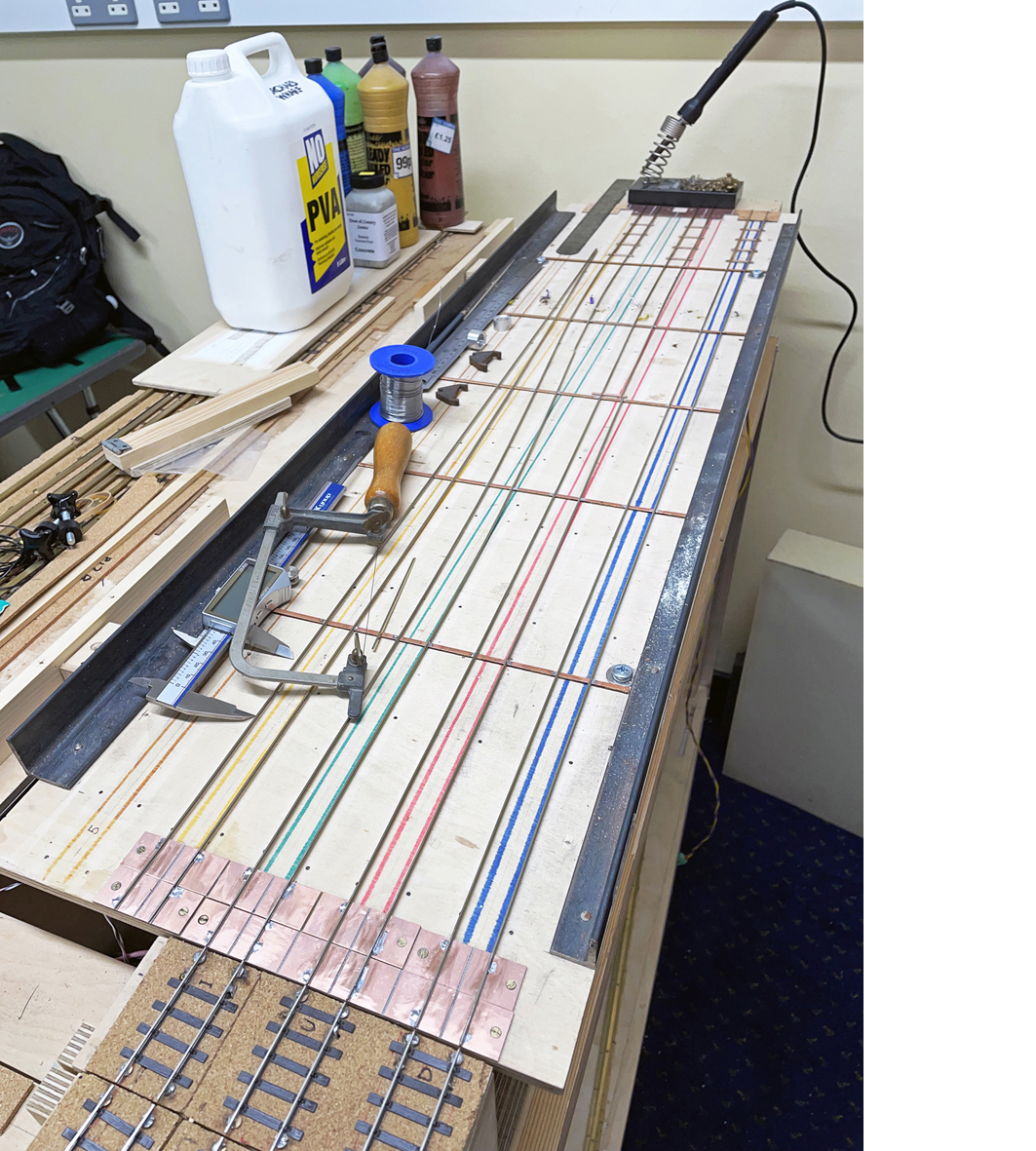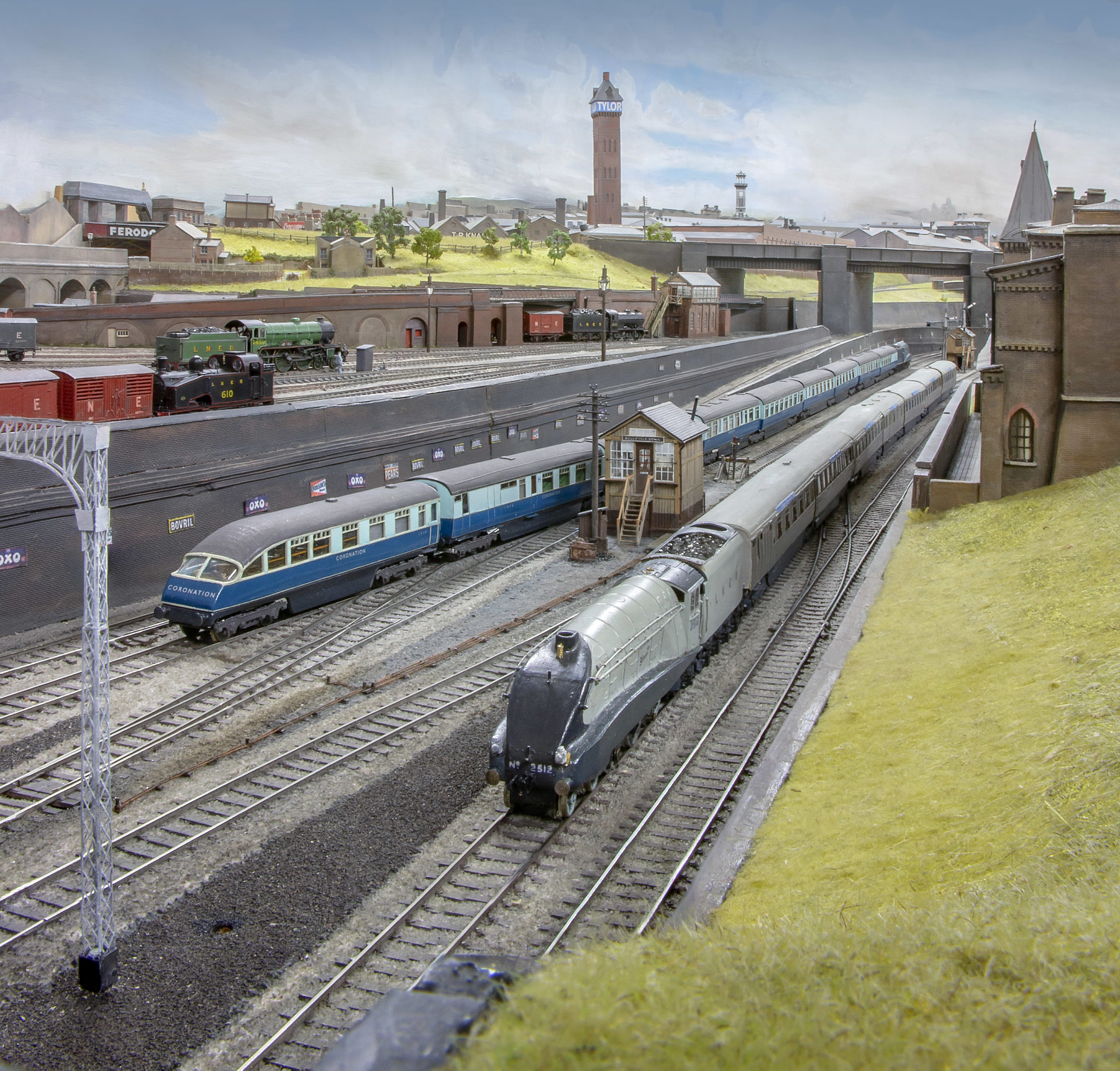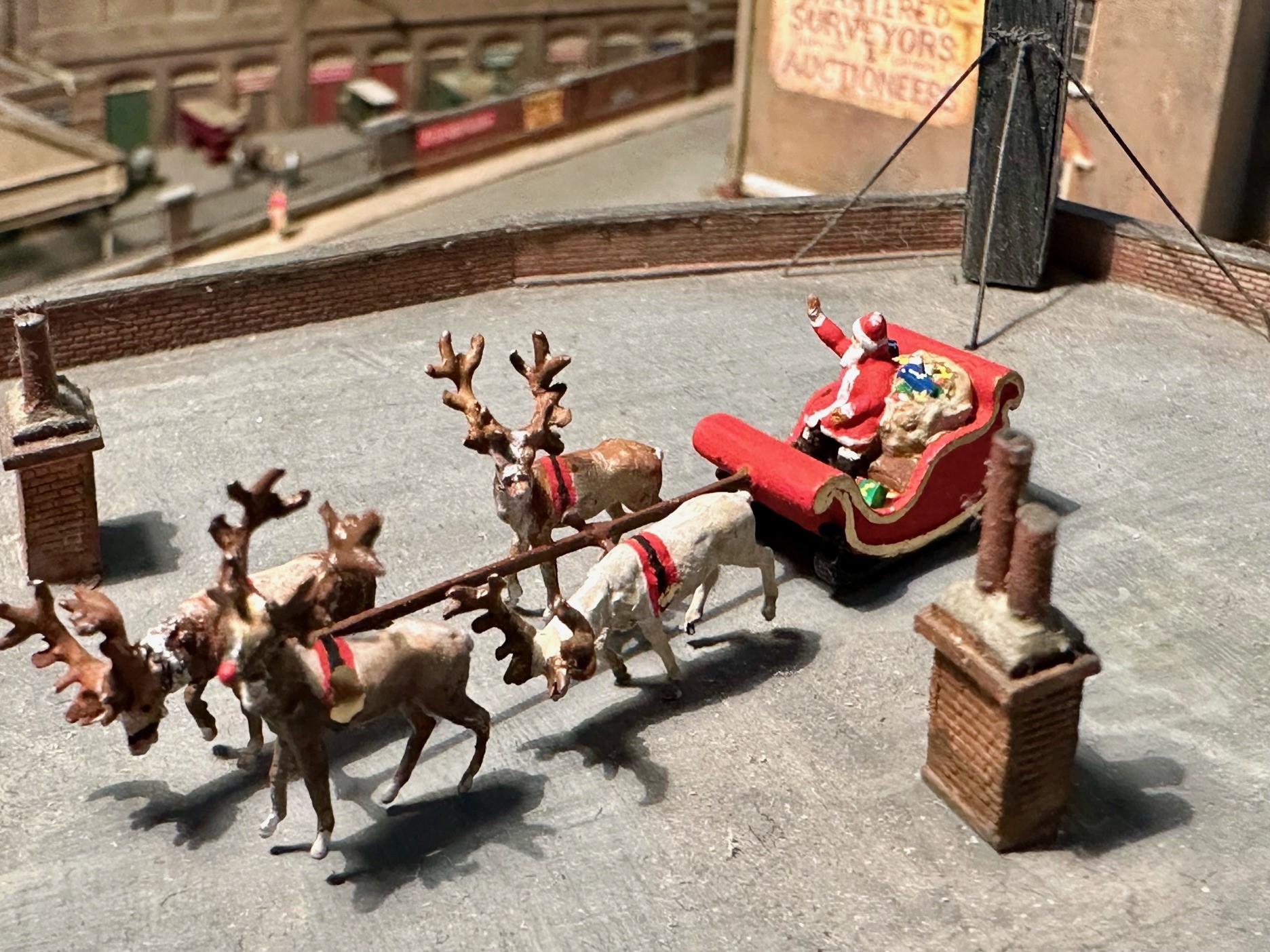Laser cut coaches
Webmaster
24th May 2020
9 minutes

Like many Railway Modelling addicts I was born sometime in the middle of the last Century. At that time The Hobby (my capitals) was pursued in a cultural climate where television was monochrome if available and heavy industry was commonplace. Being a master craftsman was a mark of distinction. Computers were unknown to the general public. What set, and still sets, this hobby apart was the multiple areas of potential enjoyment – from metal working skills through to the modelling of carriages, wagons, buildings, scenery, the application of electronics and even the organisation of clubs like the MRC. It is possible to achieve recognition as a ‘good modeller’ without knowing how to operate a machine tool. Individuality and talent is at a premium within the hobby. We reserve our praise for those who capture the essence of the subject whether it be a magnificent scratch-built locomotive, a humble wagon, a realistic tree or even an informed article on a modelling topic. There are almost no boundaries to the hobby. Because of the diverse age range and abilities of modellers our hobby does not progress at the cutting edge of technology. For example DCC (Digital Command and Control) has been around in one form or another for over forty years. However, it is still viewed by some as ‘new’ and difficult. One of my heroes from my formational period, the latter part of the 20th century, is the Rev. Peter Denny. He is my kind of modeller: neither an engineer nor an artist; not obsessed with detail; able to think laterally; a problem solver. In his books he describes himself as a ‘jack of all trades’. This belies his talent as a modeller. Peter Denny wrote two books on his Buckingham branch lines detailing the development of his layouts and the methods and techniques employed over a lifetime of devotion to the hobby. The striking thing for me about these books is that they seamlessly catalogue the development of techniques and methods employed over a period of almost half a century.
These include the adoption of the use of plastic card, which starts around the sixties, the creation of a computer to automate actions on his railway and he makes regular references to the fret saw which was the mainstay of his activities. He had the time, equipment and patience to make the many repetitive shapes accurately which is the basis of a ‘good’ model. Whether it be a locomotive, a carriage or a building the ability to manufacture identical parts is essential to the creation of a functional and visually satisfying result. Our hobby involves us in the creation of many identical parts and shapes. This can be pure drudgery. The human eye registers patterns and easily recognises small irregularities. Worst of all, many hours work can be wasted through an error in construction leaving one with the traditional dilemma: ‘To hack or discard’. Anyone who has attempted to go beyond the realms of ready made items immediately hits this issue. Now why would anyone want to make their own rolling stock? I do not really know the answer to that hypothetical question – any more than I understand why someone would want to support Manchester United in preference to Arsenal. Peter Denny describes how he came to choose the Great Central Railway. Having made his decision he kept his affection for his ‘team’ throughout his modelling career. There are a number of modellers, myself included, who chose an unpopular team – by which I mean a company which is poorly represented by the trade. Add to that the choice of an inconvenient period in time and one is faced with the necessity of making ones own rolling stock. In my case, I lay the blame squarely on my locality and also on the Model Railway Club, London, where as a youth I saw many superb models of the period I wish to model. In any event I am stuck with being a supporter of the Great Northern Railway in the period 1880 to 1914. This is tricky. Apart from the comparative lack of records relating to this period there is also a dearth of appropriate rolling stock available. Where is the ‘ready to run’ Stirling Single? How about a rake of six wheel coaches to match? Some of the most attractive coaches ever seen on British railways were the clerestory stock produced by the ECJS companies at the turn of the 20th century. As far as I know, no manufacturer has ever produced a RTR model of these vehicles although examples of both are in the national collection at York. {webitors note – Locomation has subsequently released the Stirling Single as RTR in OO gauge}
Locomotives and stock of the same period (‘Lord of the Isles’ and a Caledonian single) have appeared on the RTR market. Any locomotive which was famous enough to appear on a postage stamp as far away as Uruguay, the Stirling Single, surely deserved more than a Kitmaster kit. I apologise for my digression. My team didn’t deserve relegation guv’. One of the welcome developments during the latter part of the last century is the etching process. In fact etching as a process has been around for a long time, but these days it is possible for anyone to commission an etched fret in brass or nickel silver for a reasonable fee provided that one has the artwork. This is a mainstay of the specialist market in the UK. Etched models are available for many specialist requirements and one could not imagine our hobby without this process.
I tried the etching route and gave up in exasperation.
The issue here was the number of hours required in order to convert an etched fret into a decent model. I tried commercial frets and have also commissioned my own efforts. The limitations inherent in the process, just two layers of detail, lead to the proliferation of small detail parts which have to be laboriously applied to achieve the effect. I wanted trains – that is multiple vehicles – and I calculated that there was not enough lifetime available to me in order to realise my ambitions using etched kits. In any event, the vehicles I was trying to represent were made of wood – not metal. I can’t paint for toffee. Trying to represent varnished teak effectively was the sticky vitriol icing on the cake. For anyone who dabbles in the pre-grouping period, it will quickly become apparent that varnished teak was the medium of choice for the coaches manufactured by many companies and indeed for the LNER until grouping. In the North London area it was used by the GNR, GER, NLR and MET. Countrywide there were many more. It was a matter of economics. Varnished wood was cheaper than painted wood. To summarise my ambitions: I wanted to produce rolling stock for my period with the minimum of fuss, acceptable to the eye at normal viewing positions of the prototypes that I designated. I did not want micrometer accuracy but I did want the atmosphere of the original – something which is more easily said than done. With a pop stars income this would be easy – I could commission the lot. But where would the fun be in that?
Around about the turn of this century the first desktop laser cutter appeared on the market in America. It is called a ‘Versalaser’. For those who are not knowledgeable about lasers, the machine produces a very intense focussed beam of coherent light which literally vapourises the material at which the beam is directed. The power is controlled by switching the light on and off very rapidly. Referring to my long-winded exposition above, it seemed to me that for most purposes, a tool like the Versalaser represents the 21st century equivalent of the fretsaw. Unfortunately the price of the Versalaser was not in parallel with the cost of a fretsaw. Nevertheless I determined to obtain the beast, by hook or crook, and so began to make drawings in anticipation of that day. About two years ago I found one of these machines for sale second-hand on eBay – where else? It is now sitting in my study, fully tamed and ready for action. It took some time to learn about the capabilities of my new digital fretsaw. There are limitations to a laser. The principle limitation is that the laser cannot cut metal. It would also be somewhat unhealthy to cut polystyrene sheet as the plastic emits toxic gases when overheated. There are plastics which are suitable for use with the machine, but they are fairly expensive and I have not tried the materials yet. However the laser will cut many materials including wood, cardboard and even stone. I use wood as my preferred medium. Wood is after all, a natural form of plastic and when correctly handled is enormously strong. The ECJS clerestory coach preserved at York was originally of wood construction throughout – including the bogie frames.
All the models illustrated in this article are incomplete although some have reached an advanced state and just need buffers and couplings and final detailing to complete them. I have had limited time for modelling activities. In spite of that, I think they do show what can be achieved in a relatively short space of time using the laser.
Here is how I make Fox pattern bogies. This drawing produces the component parts for the bogie as shown below:

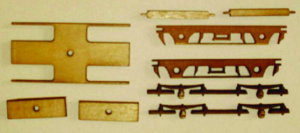
The decorative axleguards are left aside. Brass pinpoint bearings are pushed into the 2mm holes in the frames. The basic framework is assembled with the wheels using impact adhesive and left to set. The decorative axle guards are attached one side at a time with the framework held vertically once the framework is stable. The final result is a passable representation of a Fox bogie. I am using plastic ‘OO’ gauge wheels with pinpoint axles. Maunsell wheels would be correct and would be visually more impressive so at some point, funds allowing, I will upgrade the wheels. The wheels will pop out with care. I prefer to use impact adhesive as it stays flexible so adjustments like these can be made easily. Some completed bogies are shown below:
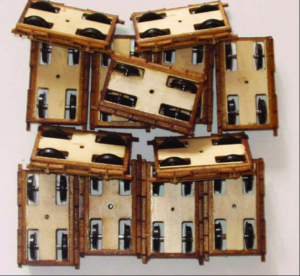
The laser operates like a printer and is treated as such by my computer. There is an auxiliary program which is used to control the laser itself. I use my favourite drawing program to create my designs and then the laser does the hard work of cutting out the parts. It does need to be watched and fed with material, a small price to pay for the results obtained. Opening the cover of the laser immediately cuts the beam in case of any problems and I have water available in a spray bottle to douse any flames if things get out of hand. So far this drastic move has only been needed a few times in the early days when I was learning how to control the beast. A feature of this machine is its ability to raster-cut successive lines of detail or to vector – cut rapidly between two points. The vector cutting strength can be varied by choosing a different pen colour which relates to a specific power setting. A typical work piece has the detail applied first by raster techniques which gives the surface detail. This is followed by a series of vector cuts to enhance detail areas, cut window apertures and finally to cut around the piece itself. This sounds complicated, but in fact is very simple once the basic principles are understood. In principle a three-dimensional image is ‘etched’ into the material and then it is cut out.
Identical parts in quantity – a railway modellers dream.
The three dimensional ability allows one to incorporate panelling and relief detail, err… rivets, to one’s hearts content. Here is a portion of the artwork for a Howlden 45ft brake van and the results in the course of assembly:
![]()
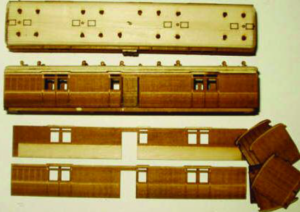
The reverse face of the carriage side in the illustration shows the removal of material for glazing bars. As one can see, the raster process produces a natural ‘teak’ finish which only needs varnishing. As with the prototype, the colour and graining varies depending on the wood. The following picture is of my first attempts at construction of my bête noir – GNR suburban birdcage stock from the 1880’s.
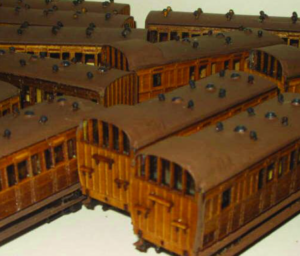
These close coupled rakes were commonplace on the lines from King’s Cross. These models do not incorporate internal detail apart from partitions. In other respects my techniques have also improved, especially in roof construction. The ventilators were added later using the laser to cut the holes. At the time of construction I simply did not have the techniques developed to permit me to make ventilators, a double sided process, using the laser. Once this was accomplished, it was an evening’s work to upgrade four rakes of about 30 vehicles using about 300 ventilators. Nevertheless, with all their faults, to me they convey something of the atmosphere of the originals. I have not yet worked out how to make the occasional carriage bend like a banana to match the state of the prototypes. It cannot have been much fun travelling in these coaches on a daily basis.
Tad Opyrchal (all photography by the author).
You can find the kits MRC member Tad has produced for sale on his website here
The second part of this article (originally published in our Bulletin) can be found in Bulletin 447 and shows some Howlden 45 foot stock which was his next project. These coaches have full interiors. An archive of Bulletins is available to members in the members section of the website. Why not Join Today
Thursday Track Nights
We are open on Thursday evenings from 7pm to 9pm at our Keen House clubrooms. Visitors are welcome, please come along and introduce yourself.
Address:
Keen House, 4 Calshot Street, London, N1 9DA
Become a member
